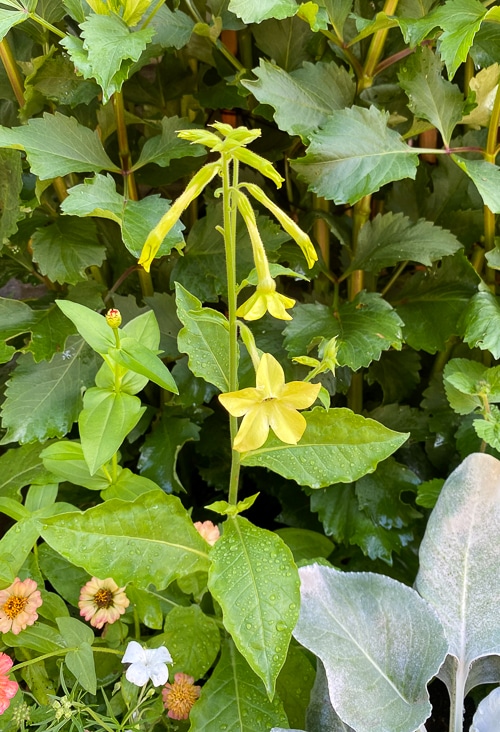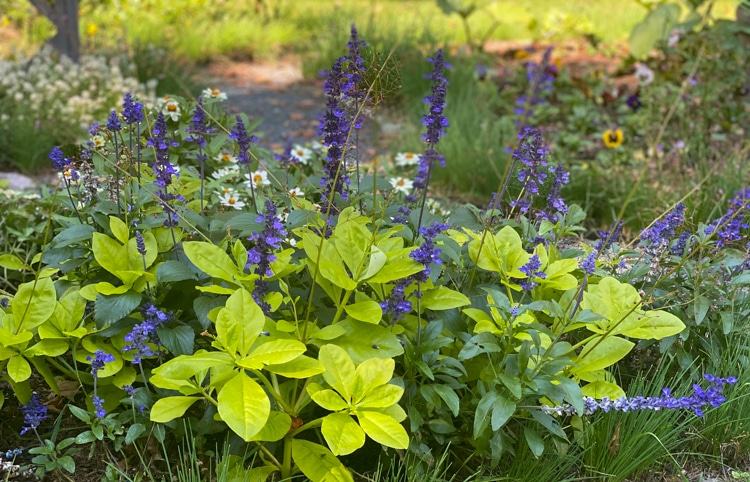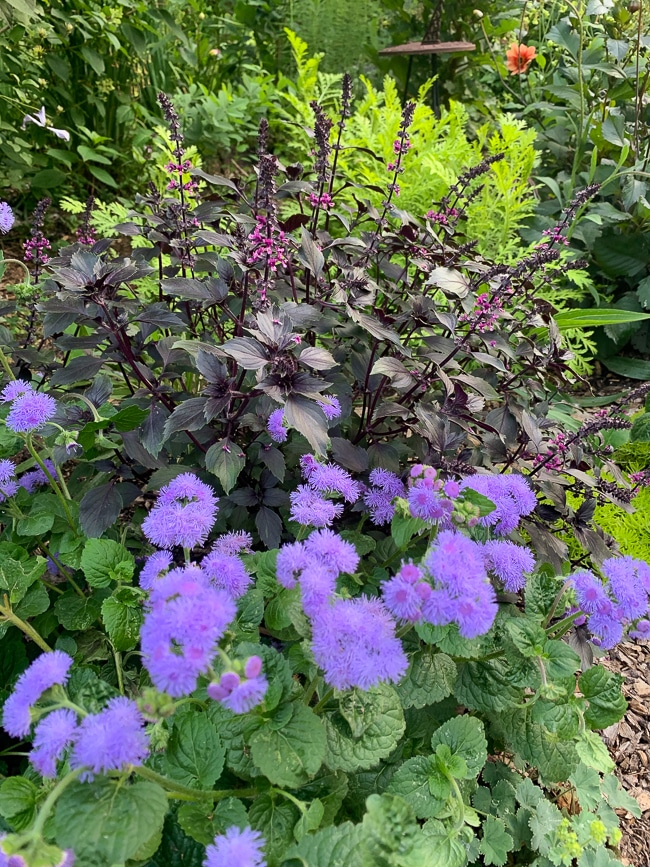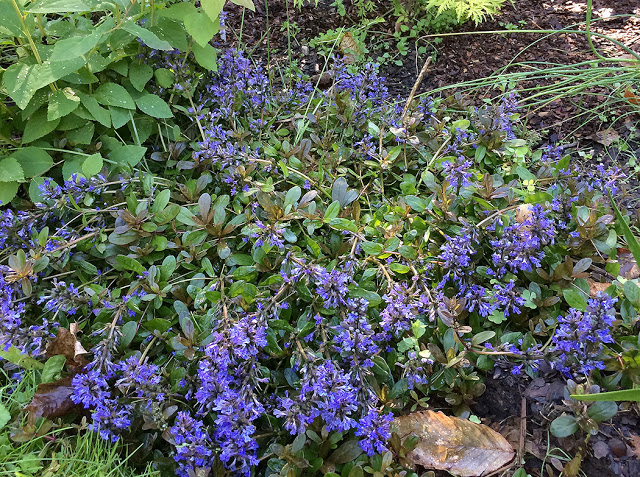Nothing stops me in my tracks more than when I’m looking at a garden jam-packed with color and texture and come across a spot of bare soil. It puts a screeching halt to well-planned flow.
Gaps in the garden happen because the plant that was supposed to be growing there didn’t, or perhaps because other plants didn’t fill the space it was expected to. Sometimes these gaps are temporary, such as when a shrub hasn’t yet filled its allotted space.
Whatever the reason, there’s plenty of time to remedy the situation and by mid summer you can have a gap-free garden without having to make another trip to the garden center.
RESEEDED ANNUALS
Reseeded annuals, which pop up in little clumps around the garden, are perfect for filing holes in the garden. Most of them transplant well if watered in quickly, and the clumps are thinned to the strongest seedlings.

In my garden there is always some Nicotiana popping up somewhere and although I have no idea what size or color will come from the seedlings, which are undoubtedly a mix of any number of potential parents I grew the previous year, almost any of them will work in holes anywhere but the very front of the border.
Now is also the time of year when I start to find Verbena bonariensis seedlings or tiny plants of its more charming cousin Verbena officinalis ‘Bampton’, both of which work as excellent fill-ins. Jewels of Opar (Talinum paniculatum) is always the last reseeder to show up and I try to save some space for it around the garden.

ANNUALS TO SOW DIRECTLY
You probably won’t have a lot of reseeded annuals popping up if you’re an over-achieving weeder or heavy mulcher, y, but there are several annuals that can be sown directly.
My go-to fill-in annual is nasturtium, which has the benefit of working in almost any sun condition and filling in large areas. The pea-sized seeds are easy to pop in the ground and will produce a large mound in several weeks. Be careful to buy a mounding variety rather than a one with a trailing habit.

Zinnias and cosmos are also good annuals to direct sow for some additional color. Keep thea seeded area moist for a couple weeks through germination and seedling infancy but once they get going they won’t ask for much other than occasional deadheading.
RAID THE VEGETABLE GARDEN
If a bit of foliage is needed, quick-growing edible plants will fill in an area and add a bit of surprise.
If you have vegetables that need thinning, consider trying to transplant thinnings to the garden to fill a few gaps. Parsley will add feathery texture and kale can provide a bold statement. Or perhaps consider the shiny leaves of Swiss chard for fabulous texture.

DIVIDE PERENNIALS
Most perennials won’t appreciate summer division, but some tougher varieties such as catmint (Nepeta), Ajuga, Lamium and others will probably bounce back with some extra care.
If you do decide to divide perennials in the hotter months, try to do it on a cooler, overcast day. Most perennials will benefit from cutting back the foliage to reduce the strain on the roots, and of course make sure to water them in well after transplanting and for a few weeks after.

`What you fill a gap in the garden with isn’t as important as just filling it with something. Consider it your chance to get creative and keep that design flow going.


19 Responses
This was a great post! its sometimes hard to remember how to fill in those holes quickly without going beyond your budget on plants you really don’t need. I also have had great success with coleus propagation in a week on the windowsill in a glass of water…and then just pop in in the ground!
Great blog
This is just the time of year where I notice my garden borders can look a little gappy. I am always reluctant to plant new perennials at this time because sometimes they struggle to “take” in mid-summer.
One trick I occasionally employ is to drop a container plant into the gap. This is especially handy for containers which are slightly past their best but still look fine from a distance.
At the end of the season I can just hoist the whole container out and plant something in autumn when the temperatures are more forgiving. At that time of year, gaps are just an invitation to head to the garden centre!
Just today I noticed this beautiful bright seedling…it looked too pretty to be a weed, and then I remembered you said Jewels of Opar reseed. Mine was in a pot last year, so I never even thought that I would find seedlings. I am so happy, I am moving them all around garden to see how they do. Thanks again for tips!
I am on the line zone 3/4 and have huge gaps in my gardens, it seems nothing reseeded from last year except the weeds! No nicotiana, no zinnia, no jewels of opar etc. Plus the starts I did earlier either never germinated or died. Out of 2 packages of sweet peas I have 6 plants. I am so very disappointed, I am not a newbie to gardening! I Just went out yesterday before the rain and tossed out some cosmos and a couple others.
Always inspiring Erin. I’m in 7a, it’s been up in the 100’s F this week, I am still thinking of seeding some zinnias and cosmos but I am thinking I need to see if we are getting one week of cooler temps, I can water every day but they don’t get water till I’m home from work. So I need to make sure they don’t dry out and roast. I’m thinking this is my best bet at having some this year. Love all your shares and suggestions, the photos are excellent too!
Timely advice as usual. I’ve been outside all day moving plants around. The garden evolves every year, have to make room for new plants and as you said, there is an abundance of seedlings to fill in the gaps! (hundreds of tall Verbana! ) Enjoy your inspiring tips.
I love this post. Just the sort of thing I needed ideas on when the mulch is thin and I have gaps that weeds are taking over. I will try these strategies in the garden, thanks Erin.
I am loving my patches of reseeded zinnias, cosmos, violets, and dill. I just threw down a pack of black-eyed susan seeds. I don’t know if they will come up, but it sure is fun when they do.
I so appreciate how well spoken you are! It’s truly a pleasure to watch your channel and read your updates, keep them coming!
OMG. I just came in from my garden where I was noticing gaps. I’m going to my garden store tomorrow!
Thankyou for this great article! When is it too late to direct seed zinnias, cosmos, and jewels of Opar? I’m zone 5b northern Illinois and I’d like to throw some down
Nasturtiums are my fav! I love looking at them and eating them! I love the basil idea! I never thought if that one! I love your posts so much!
Great suggestions. I sowed quite a few zinnia and calendula seeds in 4 inch pots for just this purpose-except my gaps tend to be in the back so didn’t quite do the trick. My biggest gaps are where my hardy hibiscus are. Empty area until late June when they start to fill the gap themselves-I could use some suggestions for those spaces.
I’ve had my eye on that blue cheer delphinium since I saw it last year. Never could find a place to buy a plant or seeds. Where did you find it! Gorgeous color!
Erin
Based on your posts about annuals from seed, I grew cosmos, nasturtium, calendula, zinnia, marigolds, snapdragons, and sweet peas this year. I really looked forward to nicotiana alata Lime Green, but then got concerned when I read about toxicity to domestic animals. I do not have any pets but my neighbor’s cat visits my yard often. I have not put any nicotiana in the ground, am I being overly concerned about the toxicity? I did put Lime Green in containers on my raised deck since my neighbor’s cat does not come up there. thank you.
I only planted Jewels of Opar for the first time last year. I never knew they reseeded. I have been pulling all these little light green sprouts till I realized that’s what they were! I love it! Although I gotta say, I am glad I like them because there are quite a few! lol
Those peach colored Nasturtiums are beautiful. Could you tell me what variety they are? Thank you for this post! I now have some ideas for a few glaring, unexpected gaps I’ve encountered this year.